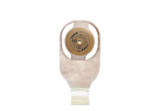Products List
-

ConvaTec ActiveLife - 10" Drainable 1-Piece Ostomy Bag w/Stomahesive Skin Barrier (Pre-cut)
Convatec ActiveLife1402$43.95 - $81.45Comfort panel is odor proof and quietComes with tape collar and tail closureIdeal for those with colostomies and ileostomiesBox of 10, box of 20 (1" opening only available in box of 10)ConvaTec ActiveLife - 10" Drainable 1-Piece Ostomy Bag with...Quick view -


ConvaTec ActiveLife - Drainable 1-Piece Ostomy Bag w/Stomahesive Skin Barrier (Pre-cut)
Convatec ActiveLife1401$43.95 - $81.45Drainable ostomy pouchPre-cut skin barrier for convenienceComfort panel is both quiet and odor proofOstomy supplies for colostomies and ileostomiesOpaque: Box of 10, Transparent: Box of 20ConvaTec ActiveLife - Drainable 1-Piece Ostomy Bag with...Quick view -


ConvaTec ActiveLife - Drainable 1-Piece Ostomy Bag with Stomahesive Skin Barrier (Cut to Fit)
Convatec ActiveLife1396$44.45 - $84.45Ostomy supplies for colostomies and ileostomiesCut-to-Fit one sided comfort panel (3/4" - 2 1/2" stoma size)Drainable one piece ostomy pouch with Stomahesive Skin barrierBox of 10, box of 20ConvaTec ActiveLife - Drainable 1-Piece Ostomy Bag with...Quick view -


Coloplast SenSura Mio - Transparent Drainable 1-Piece Cut to Fit Ostomy Bag
Coloplast Sensura Mio32510$47.45TransparentOne-piece ostomy bag includes built ostomy waferSensura Mio Drainable PouchCut to FitBox of 10Coloplast SenSura Mio - Transparent Drainable 1-Piece Cut to Fit Ostomy Bag is made of an ultra soft transparent material so monitoring stomal output...Quick view -

ConvaTec ActiveLife Convex - Drainable 1-Piece Ostomy Bag (Pre-cut)
Convatec ActiveLife1414$61.45 - $61.95Allows active/extended wearIdeal for those with mostly liquid outputDiscrete, odor proof, and quiet ostomy suppliesDeep convexity gives extra protection for retracted or flushed stomasBox of 5ConvaTec ActiveLife Convex - Drainable 1-Piece Ostomy Bag...Quick view -


Hollister Premier - 12" 1-Piece Drainable Ostomy Bag (Flextend - Transparent)
Hollister Premier1710$51.45 - $51.95FlexTend skin barrier, ideal for extended wearOdor-barrier and rustle-free film for protection from odor and pouch noiseOstomy supplies with porous cloth adhesive and tape borderPouch clamp closure on drainable pouchBox of 10Hollister Premier - 12"...Quick view -


Coloplast SenSura Mio - Drainable 1-Piece Ostomy Bag with Easi-Close Wide Outlet (Pre-cut)
Coloplast Sensura Mio3972$43.95 - $47.45Elastic barrier moves with the bodyEasi-Close wide outlet for added security and movementLarger full circle filter to reduce ballooning for added comfortSenSura Mio fits right and feels right, more like real clothing and less like a medical deviceBox of...Quick view -


ConvaTec ActiveLife - Drainable 1-Piece Ostomy Bag with Durahesive Skin Barrier (Cut to Fit)
Convatec ActiveLife1430$56.95Quiet, odor proof comfort panel Easy to manage one-piece systemWafer protects skin against semi-liquid to liquid stoolConvaTec ActiveLife - Drainable 1-Piece Ostomy Bag with Durahesive Skin Barrier (Cut to Fit) combines a Durahesive skin barrier and...Quick view -


Hollister Premier - 12" 1-Piece Drainable Ostomy Bag Lock-n-Roll (Flextend - Cut to Fit)
Hollister Premier1706$51.45Easy to empty and easy to cleanDrainable pouch with Flextend skin barrierLock n Roll closure system for security and convenienceOdor-Barrier and Rustle-free film (beige pouch) provide confidenceLock-n-Roll closureConvex skin barrier is ideal for those...Quick view -


Coloplast SenSura - 1-Piece Convex Ostomy Bag with Easi-Close Wide Outlet (Cut to Fit-Maxi)
Coloplast SenSura3667$73.45Filter works automaticallyConvex wafer for hard to fit stomasCut-to-fit: 5/8" - 1 11/16" waferEasi-Close Wide Outlet for easy drainingDouble-layer adhesive is permanently fixed to the pouchBox of 10Coloplast SenSura - 1-Piece Convex Ostomy Bag with...Quick view -


Hollister Premier - 1-Piece Closed Ostomy Bag (Cut to Fit)
Hollister Premier1702$93.45SoftFlex skin barrierComfortWear panelsIntegrated filter prevents gas buildupPremier ostomy pouch is ideal for those with sensitive skinRustle-free odor barrier film eliminates pouch noise and odorBox of 30Hollister Premier - 1-Piece Closed Ostomy Bag...Quick view -

Hollister Premier - 12" 1-Piece Drainable Ostomy Bag w/ Lock n Roll and Filter (Convex CeraPlus-Pre-Cut)
Hollister Premier4477$58.45Pre-cut holeBuilt-in filterAdhesive bordered flangeTransparent viewing windowLock n Roll microseal closureExtended wear ostomy barrierBox of 5Hollister Premier - 12" 1-Piece Drainable Ostomy Bag w/ Lock n Roll and Filter (Convex CeraPlus-Pre-Cut)...Quick view







